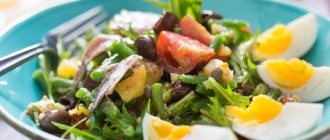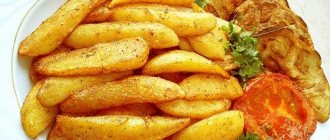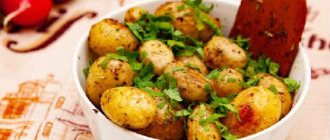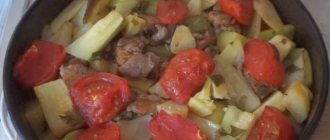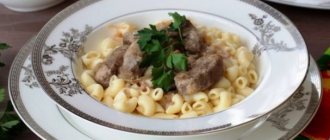Kinds
Thanks to the efforts of breeders, a huge number of varieties and species of this unpretentious vegetable have been developed. Zucchini can be round, smooth, pear-shaped, ribbed, yellow, white, spotted or striped.
Conventionally, all zucchini can be divided into classic, spaghetti, zucchini, and decorative varieties.
The simplest types are characterized by a cylindrical shape, light green skin and dense pulp. Black, green and yellow zucchini are smaller in size, have tender centers and lack large seeds, even when overripe. Spaghetti squash is a special variety because it has a layered structure; after boiling, it resembles popular Italian pasta. Decorative specimens are characterized by any shape and color.
Popular varieties
The popularity of zucchini has attracted interest from plant breeders. Many varieties have appeared with different characteristics and colors. Let's look at some of them.
Tsukesha
Approved for cultivation in the Central, Middle Volga and Far Eastern regions. Recommended for spring film greenhouses. The fruits reach technical ripeness 51 days after seed germination. The bush has no side shoots. The main lash is short. The large, dark green, highly dissected leaf has a five-lobed shape. The fruit is cylindrical, up to 40 cm long. Average weight is 890 g. The skin is thin, smooth, dark green with light green specks. The pulp is white, juicy, and has excellent taste. Productivity is good - up to 12 kg per 1 m². Gray mold is affected to a moderate degree.
Zucchini Tsukesha - an early ripening popular variety
The new variety of zucchini, Tsukesha, is distinguished by its bushiness, and this is exactly what I like. I don’t have a lot of land and every piece is worth its weight in gold, so the appearance of this variety allows me to harvest a significant area of the garden.
Pomidorchik
https://forumsadovodov.com.ua/viewtopic.php?p=6136
Little Negro
In 2007, it was included in the State Register for the North Caucasus and Far Eastern regions. The growing season is short - 43 days. The bush is compact, with small, heavily dissected leaves. The surface of the plate is spotted, with slight pubescence. The fruit is of medium length, cylindrical in shape with a small diameter. The skin is dark green with diffuse spotting. Weight from 400 to 900 g. Taste is excellent. Productivity is good - 464 - 777 c/ha. Has relative resistance to low temperatures.
Zucchini Negrotenok has excellent taste
The Negro is dark green, glossy, the fruit is even, elongated, the taste is the best of all that I have tried, similar in appearance to Aeronaut, but not so large
amplex
https://forum.prihoz.ru/viewtopic.php?t=1186&start=795
Golden
In 2010, it was approved for cultivation in all regions of the country. Recommended for open ground in private farms. It begins to bear fruit 40–45 days after emergence. The plant is medium-climbing, with strongly dissected leaves of medium size. The surface of the plate is dark green, with slight spotting. The fruit is cylindrical, with medium to strong ribbing. The skin is yellow, there are small dots. The pulp is tender, dense, slightly sweet in taste. Fruit weight is from 700 g to 1 kg. Productivity 5.2 kg/m².
Zucchini Zolotinka, thanks to its dense peel, stores well
I have grown this variety several times. The yield is really very good. But I can’t say the same about disease resistance. Much more often affected by rot compared to dark green zucchini.
masko4
https://chudo-ogorod.ru/forum/viewtopic.php?f=63&t=1927#p13234
Tiger cub
Year of inclusion in the State Register 2008, approved for cultivation in all regions. Recommended for growing in private farms. From the germination stage to fruiting, 60–65 days pass. The plant is a weakly branched bush with small, strongly dissected leaves. The fruit is long, curved, cylindrical in shape. The surface is ribbed, the color is characterized by alternating dark green and light green stripes and strong diffuse spotting. The pulp is dense, tender, and has a pleasant light cream color. The weight of a ripe fruit is from 720 g to 1.2 kg. Productivity 5.7 – 7.4 kg/ha. It is drought resistant.
Zucchini Tiger Cub - drought-resistant variety
Zucchini is just for food, I like Tiger Cub and Murzilka. I plant 2 bushes in 2 holey barrels, but it’s better to have 1 bush each, as they crush each other
GALAS
https://flower.wcb.ru/index.php?showtopic=14318&st=40
Skvorushka
Approved for cultivation in the Central and Volga-Vyatka regions in 2009. Recommended for personal plots. The period from full germination to technical ripeness is 46 – 57 days. The plant is bushy, compact. The leaves are medium-sized, slightly dissected. Having reached technical ripeness, the fruit acquires a curved pear-shaped shape. The surface is slightly ribbed, green, and decorated with a pattern in the form of specks. The pulp is medium density, tender, with excellent taste. Fruit weight is from 700 g to 1.1 kg. Productivity is higher than standard varieties - 580 - 735 c/ha. Differs in drought and cold resistance.
Zucchini Skvorushka can withstand cold spells and dry periods
This year I sowed Skvorushka - it’s kind of scary. Not only is it NOT soft, but it hasn’t really had time to bloom yet, and the skin is already wooden. And about 3 years ago I planted them - they seemed to be softer.
MurziK
https://chudo-ogorod.ru/forum/viewtopic.php?f=63&start=20&t=633
Aeronaut
The admission regions are Central, Volga-Vyatka, North-Western, Lower Volga, Ural, Far Eastern, East Siberian. The year of entry into the State Register is 1987. 46 days pass from full germination to the harvesting period. A compact bush plant with a short main shoot and a few vines. The fruit is cylindrical with a smooth surface and dark green in color. There is a pattern in the form of small dots of light green color. The pulp is crispy, dense, juicy, tender, whitish-yellow in color. Taste qualities are noted as good. The weight of the fetus is 1.3 kg. Productivity 7 kg per 1 m². Resistance to viral diseases is strong, and resistance to powdery mildew is above average. Has excellent transportability.
Zucchini Aeronaut is prized for its disease resistance
In general, we liked Aeronaut the most - they grew earlier than everyone else, they were very productive and tasty.
Tisa
https://chudo-ogorod.ru/forum/viewtopic.php?f=63&start=20&t=633
Recent Entries
Lilac perennials that are beautiful, compact and do not crowd out other plants Why when buying seedlings you should not take the sellers’ word for it and how to determine the age of the plant using 3 signs Tomato seedlings have turned purple or whitish: why the color has changed and how to save the plants
Properties
Every housewife should know how to cook young zucchini, as it has a mild and mild taste, thanks to which it can be combined with a wide variety of products - meat, poultry, cheeses, cereals and pasta.
The energy value of this vegetable is not at all high, only 18–20 kcal per 100 grams, thanks to which it is used as part of a huge number of diets. In addition, it has the properties of removing unnecessary moisture from the body, which makes it indispensable in the fight against excess weight. The fiber contained in fruits activates the digestive tract, improves intestinal motility, and increases metabolic processes.
Zucchini has an excellent effect on the functioning of the cardiovascular system, as it cleanses the blood of excess salts, toxins, cholesterol and strengthens the walls of blood vessels. Potassium and magnesium contained in the composition regulate blood pressure, thereby preventing hypertension. The iron contained in fruits normalizes the composition of the blood and increases its ability to retain oxygen.
Mothers need to know how to cook young zucchini, as it does not cause allergies and is suitable as the first food for babies.
If you regularly eat this fruit, you can improve your immunity, and thanks to the presence of vitamins C, B1 and B3 in it, the body perfectly fights infections and viruses, and also slows down the aging process.
People who suffer from gastritis, peptic ulcers and kidney-related ailments should not consume various dishes made from zucchini.
general characteristics
Zucchini is an early ripening member of the pumpkin family, which is the closest relative of zucchini. By the way, the name of this fruit comes from the Italian “zucca”, meaning “pumpkin” [1]. They differ from other representatives of the zucchini genus by their very delicate green or yellowish skin and juicy, crispy white flesh. The main difference between zucchini and zucchini is faster ripening (vegetables can be harvested 4-7 days after the ovary appears). There is also a noticeable difference in the size of both fruits: zucchini is usually larger, and the ideal size for zucchini is 15 cm. Another advantage of zucchini: despite the fact that the chemical composition of all types of zucchini is very similar, this variety is absorbed by the body much easier.
Content:
- general characteristics
- Nutritional characteristics
- Benefits for the body
- Use in folk medicine
- Possible hazardous properties
- Vegetable for beauty
- Use in cooking
It is believed that the first zucchini appeared in South America 10 thousand years ago. In those ancient times, wild zucchini was significantly different from the ones we are used to eating today. South American tribes used these ancient squashes primarily for their seeds, as their flesh was quite bitter.
In the 16th century, zucchini, thanks to the conquistadors, crossed the ocean and came to Europe. Researchers suggest that it was the Italians who were the first to “domesticate” this green overseas guest and learned to prepare the most incredible delicacies from it. And in the 18th century in Europe, young zucchini began to be consumed with might and main. And since the vegetable came to Russia from Italy, it is not strange that for many years it was called Italian zucchini here.
Today, this vegetable is an indispensable component of low-calorie diets, as it has a very low glycemic index. Due to their high water content, zucchini contains virtually no calories, but is a good source of some minerals and vitamins [2]. Cooks also love this product. Zucchini lends itself well to almost any cooking method.
Zucchini recipes
The most delicious vegetables are young and tender specimens, which still contain very small seeds. You don’t have to peel them, as you won’t be able to feel the skin after cooking. In the summer, they are sold at a very affordable price in every vegetable stall, so you need to know quick and tasty recipes. Young zucchini can be served in a variety of forms: they are baked, stewed, fried with potatoes, stuffed, a huge number of snacks, omelettes and preserves are made.
There are a large number of recipes with this wonderful vegetable, because it is so tasty and healthy, easy to digest and quick to prepare.
Freezing and drying fruits
Due to the high starch content and watery pulp, it is almost impossible to dry the vegetable. That is why, for long-term storage, housewives choose the second method - freezing in the freezer. For long-term preservation, it is best to choose varieties developed in Russia. As an option: “Snezhnogorsk F1” (hybrid), “Pippi” and “Russian delicacy”.
How to fry young zucchini
When preparing such a dish, you do not need to adhere to certain strict proportions. The quantity of products is determined individually, depending on the number of people for whom the dish will be prepared. Before frying, you need to rinse the vegetables under running water, and then cut them into slices and cover them with spices. Next, the dish is laid out in a frying pan and fried on both sides.
Another cooking option is to soak it in an egg mixture and flour. This dish requires constant monitoring as it can easily burn. To prepare, mix spices, mayonnaise and a clove of garlic grated on a fine grater in a separate bowl. Before serving, the fried vegetables are rubbed with the prepared mixture. Young zucchini with garlic are the calling card of almost every housewife, as they are very tasty and unpretentious to prepare.
Description
Zucchini is very useful for humans, it contains:
- many vitamins and microelements that have a positive effect on the general condition of the body
- fiber, which helps normalize digestion and cleansing functions of the body
- a small amount of calories, which allows the product to be used in dietary nutrition to normalize weight
Variety of zucchini
Excellent taste and variety in preparation make zucchini simply a favorite dish for many consumers during their fruiting period.
Baked zucchini with cheese
Such a dietary snack will be an excellent option to help diversify the boring menu of a person losing weight.
Ingredients:
- 200 grams of hard cheese;
- 2 medium sized zucchini;
- 3 cloves of garlic;
- pepper;
- 2 tbsp. l. low-fat sour cream;
- salt.
In order to bake young zucchini, you must first wash and peel them. Then the fruits are cut into thin rings. Cheese and garlic are grated and placed in a separate container. Next, you will need a glass tray, which is lined with parchment, and a zucchini seasoned with salt and pepper is laid out on top, then everything is sprinkled with garlic and cheese and placed in a well-heated oven for 15 minutes. After cooking, the dish is seasoned with finely chopped herbs.
How is it different from zucchini?
There are a number of criteria that distinguish two vegetables belonging to the same family:
- Zucchini has a more delicate taste.
- Zucchini has a light green or white color, while its counterpart is dark green or yellow, sometimes with a pattern of small dots.
- The Italian vegetable has a long shelf life.
- Zucchini has a hard skin and is often used for frying or stewing. Zucchini is characterized by the presence of thin and tender skin, so it can be eaten raw and used in salads.
You can recognize the “Italian pumpkin” bush by its compactness and small number of shoots, when the zucchini requires a lot of space to grow.
Young zucchini with minced meat
There are a huge number of dishes with this vegetable; it will be very tasty if you add a little ground meat to them. The option proposed below is distinguished by its excellent taste, tenderness and low calorie content.
Ingredients:
- 1 tomato;
- 3 tbsp. l. grated cheese;
- 2 zucchini;
- 0.5 kg minced meat;
- favorite seasonings.
The fruits are cut into several large pieces, and a deep notch needs to be made in the middle of each. The end result should be barrels. All parts are coated with spices. The cut out center is grated and added to the minced meat. Next, the holes are filled with the prepared mass and laid out on a baking dish, the tomatoes are cut into plates and serve as lids, and then everything is sprinkled with cheese and sent to a well-heated oven until cooked.
Which benefit or harm predominates?
“Italian zucchini” is characterized by a multi-element composition, which includes vitamins and minerals. They take an active part in strengthening and healing the body:
- potassium ensures normal heart function, has a preventive effect against atherosclerosis and anemia, prevents the negative effects of sodium, strengthening the heart muscle;
- folic acid is considered an essential vitamin for pregnant women, as it prevents anemia and promotes normal fetal development;
- fiber improves digestion, heals the intestines, eliminates toxins and bad cholesterol;
- vitamin C reduces the risk of diabetes and cancer, and also eliminates the symptoms of arthritis and asthma;
- lutein and zeaxanthin are powerful phytonutrients that have a positive effect on the visual organs, preventing the development of age-related ophthalmic pathologies.
The December 2000 issue of Healthy Nutrition Society published a study that confirmed zucchini's ability to prevent the development of benign prostatic hyperplasia. Green zucchini contains antioxidants that are involved in the oxidation of carcinogens and free radicals.
Vegetables with traces of mold on the cut or peel should not be eaten.
What are the possible contraindications?
Zucchini is not recommended for consumption by people with pathologies:
- tendency to urolithiasis;
- renal failure;
- gallbladder diseases;
- gastritis or stomach ulcer.
The vegetable contains oxalates, which provoke the development of urological diseases and interfere with the normal absorption of calcium in the body.
Baked zucchini
This dish is very tasty, and its preparation does not require much time or effort.
Ingredients:
- 500 grams of zucchini;
- 100 grams of flour;
- salt;
- 100 ml milk;
- 1 clove of garlic;
- 100 grams of cheese;
- 100 grams of breading.
The oven is heated to 200 degrees. The baking sheet is covered with parchment. Vegetables are cut lengthwise into 4 parts, each of which is distributed into 4 more parts. Mix salt, grated garlic, sifted flour and pepper in a bowl. All pieces are carefully rolled in the prepared mixture and laid out on a dish. Milk and eggs are combined, and the breading is mixed together with the cheese. Then the vegetables are dipped one at a time into the egg mixture, generously sprinkled with breading and placed on a baking sheet. After the young zucchini has browned in the oven and become quite soft, they can be taken out and served. It will also turn out very tasty if you prepare the sauce in advance. A tomato mixture would be perfect for this dish.
Vegetable for beauty
Zucchini, like other vegetables and fruits, is rich in many nutritional components that are important for maintaining healthy, beautiful skin and hair. In particular, eating zucchini and using masks made from crushed vegetable pulp helps moisturize the skin. This vegetable returns a healthy color to the skin, and antioxidants help fight the first wrinkles and age spots. In addition, regular consumption of zucchini promotes the production of collagen, without which the skin becomes loose and wrinkled. A balanced diet is beneficial for beautiful and healthy hair, and zucchini plays a vital role in this matter. This vegetable supplies the hair with vitamins, protects it from dryness, and saves the scalp from dandruff.
Stewed zucchini with tomatoes
This dish, like many others, is dietary, since large quantities of fat are not used for its preparation.
Ingredients:
- 2 zucchini;
- 2 ripe tomatoes;
- 1 salad pepper;
- 1 carrot;
- 1 onion;
- 3 cloves of garlic;
- salt;
- greenery;
- olive oil.
Everyone should know how to cook young zucchini, as it makes very tasty and unusual dishes. The vegetable is washed and then cleared of seeds and peel. The pulp is cut into cubes, the onion and pepper also need to be finely chopped. The tomato needs to be peeled, first dipped in boiling water and chopped. The carrots are grated. Place all the vegetables in a frying pan with a small amount of olive oil, fry a little over medium heat, and then turn it down. After cooking, sprinkle the dish with small herbs and can be served.
Climatic features
In order for the plant to take root and please the gardener with a noble harvest, when choosing seeds you should learn in detail about the temperature recommended for planting in open ground. For example, if the garden is located in the southern part (Krasnodar Territory or Crimea), you can consider any seeds that are immune to burning in the open sun. For Siberia and the Urals, it is more correct to choose one of the options for hybrid seeds, which allow you to grow zucchini at an accelerated pace, without waiting for the temperature to drop. In the Leningrad region and for central Russia, breeders advise choosing any varieties of zucchini and zucchini that are adapted to sudden changes in weather.
If you don’t have a garden plot, but you want to start growing eggplants at home on the balcony, you should choose miniature or dwarf varieties. A good solution would be: Golden F1 (a hybrid that requires garter) or Patio Star F1 (small size).
Country-style pickled zucchini
The dish is an excellent appetizer that will fit perfectly on any table.
Ingredients:
- 30 grams of dill;
- 1 pod of hot pepper;
- 10 cloves of garlic;
- 80 grams of salt;
- 5 peas of allspice;
- 1 kg of zucchini;
- 80 grams of 9% vinegar;
- 1 liter of water.
These are very tasty young zucchini; many housewives often prepare them for the winter. The fruits are cut into thin circles and placed in a separate container. Chop the dill, and cut the pepper and garlic lengthwise into a couple of pieces. Place the prepared spices and herbs on the bottom of the jars, and then fill everything tightly with zucchini. Next, the marinade is prepared, the water is boiled and vinegar and salt are added, and then everything is poured into containers. Then the jars are sterilized in boiling water for 15 minutes and rolled up.
Snack zucchini muffins
Delicate snack cupcakes that you will definitely like and delight with their taste.
Ingredients for cooking:
- One small young zucchini;
- Two eggs, one teaspoon of sugar;
- 100 grams of bacon or good smoked sausage;
- 6 tablespoons of flour and 1.5 teaspoons of baking powder.
If desired, you can double the quantity of products.
Making snack cupcakes:
- Wash the zucchini and grate it on a coarse grater, add salt and place in a colander. This is necessary so that the excess liquid is drained.
- Mix eggs, flour, baking powder and sugar. Then add well-squeezed zucchini and mix everything.
- Finely chop the bacon or sausage and add to the zucchini dough.
- Prepare the molds; it’s convenient to bake cupcakes in a silicone mold. Place the dough in them.
- Preheat the oven and bake the cupcakes at 200 degrees until golden brown.
The result is a delicious snack dish that is convenient to take with you on the road or outdoors.
Pickled spicy zucchini
It is a dish for future use and is great to eat in the cold winter.
Ingredients:
- 80 grams of 9% vinegar;
- 450–600 grams of zucchini;
- 1 liter of water;
- 2 bay leaves;
- 15 black currant leaves;
- 5 peppercorns.
- 5 cloves.
And now you need to figure out how to cook young zucchini so that it is tasty. The vegetable is peeled and the middle is removed, and then everything is cut into cubes of several centimeters. Blanch the zucchini for 5-7 minutes in boiling water and then cool in cold water. Next, you need to prepare the marinade, pour sugar, salt, vinegar and spices into boiling water, and then remove from heat. Fill the jars tightly and add the prepared liquid. Pasteurize the twists for 20 minutes and roll up.
The best varieties of zucchini and zucchini to store
2020 can please you with the five best varieties for storage that retain their appearance and pulp:
- Spaghetti;
- Gribovskie 37;
- Motley;
- Winter Russian size or F1 delicacy.
Options for canning
To prevent bombing in the pantry or cellar in the winter, and to ensure that the taste of the product is suitable for preserving appetizers, caviar, jam and even compote, you should choose varieties with excellent taste and a pleasant aroma.
For salted canning, the best ones are: Sangrum, Kolobok, Gherkin and King of the Market. All varieties, except for “Gherkin”, are hybrids, bearing the F1 mark on the seed packaging.
For sweet preserves, you should choose sweet eggplant pulp, which has a maximum sugar content. The following have been included in this list for several years in a row:
- Walnut;
- Pineapple;
- Winter delicacy, Orange and Tender marshmallow F1 (hybrid varieties).
Adjika from zucchini
Many housewives are wondering what to make from young zucchini, since there are a lot of them in the summer. Adjika from them is a universal sauce that is suitable for many products.
Ingredients:
- 10 tbsp. l. tomato paste;
- 3 tsp. ground pepper;
- 2 cloves of garlic;
- 5 tbsp. l. 9% vinegar;
- 3 kg of zucchini;
- 2 hot peppers;
- 1 cup vegetable oil;
- a bunch of parsley or dill.
Peel the zucchini and pass them through a meat grinder. Then put it in an enamel pan and add oil, salt, tomato paste and pepper, and then simmer for 1.5 hours. Then dilute the vinegar in a glass of water and pour into the zucchini, add herbs and garlic. Simmer the prepared dish for 10 minutes. Distribute among jars and roll up.
What is the peculiarity of the nutritional and chemical composition
Sweet and juicy zucchini is a low-calorie product that contains:
- complex of vitamins and minerals;
- easily digestible carbohydrates;
- fiber;
- Sahara;
- polyunsaturated fatty acids;
- phytonutrients;
- antioxidants.
The calorie content of 100 g of fruit is 16 kcal, of which:
- proteins – 1.5 g;
- fat – 0.2 g;
- carbohydrates – 3.0 g.
A 200g serving of chopped zucchini contains approximately 190g of water.
| Chemical composition (per 100 g of product) | Amount, mg |
| Vitamin A (beta-carotene) | 0,025 |
| Vitamin B1 (thiamine) | 0,042 |
| Vitamin B2 (riboflavin) | 0,036 |
| Vitamin B5 (pantothenic acid) | 0,367 |
| Vitamin B6 (pyridoxine) | 0,142 |
| Vitamin B9 (folic acid) | 0,02 |
| Vitamin C (ascorbic acid) | 34,1 |
| Vitamin PP (nicotinic acid) | 0,705 |
| Potassium | 459,0 |
| Phosphorus | 93,0 |
| Copper | 97,0 |
| Magnesium | 33,0 |
| Calcium | 21,0 |
| Sodium | 3,0 |
| Iron | 0,79 |
| Zinc | 0,83 |
| Manganese | 0,196 |
Zucchini contains 15% of the daily value of ascorbic acid. The vegetable should be taken regularly by children and people with weak immunity and a tendency to frequent viral diseases.
Zucchini flower
Zucchini puree for babies
The birth of a child is always a holiday; after time, the baby grows and switches to adult food. Therefore, every mother begins to wonder where to start. Young zucchini is perfect for this. All parents should know tasty and quick recipes, since this particular product is optimal for the baby. If possible, you should purchase small-sized green-fruited vegetables, since they have more tender and pliable pulp and completely soft seeds. They also contain carotene, which is so beneficial for children's vision.
1. After a worthy specimen has been selected, it is thoroughly washed under cold water, the peel is removed and rinsed again.
2. Next, everything is cut into cubes and boiled until softened in a small amount of water. A healthier option is steaming. The time in one case or another should not exceed 10 minutes.
3. For pureeing you need to use a chopper or blender. It is not recommended to use a grater or fork for this, as the dish will turn out rough and it will be difficult for a small stomach to process it.
It is not recommended to store it in the refrigerator, so you need to prepare it for one serving. You can also use pre-frozen zucchini for this if complementary foods need to be introduced in the winter.
Planting zucchini
Zucchini can be grown in two ways - seedlings and seeds. Each of them has its own characteristics.
Planting seedlings
A tender and heat-loving crop in regions of risky agriculture is best grown by seedlings. But it’s better not to rush into sowing seedlings, especially if you live in regions with a cold climate. As a rule, sowing is carried out in the middle or end of April, with the expectation that transplantation into the ground should take place in 25 - 30 days.
Zucchini seeds do not lose their ability to germinate for 10 years. But 2-3 year olds are considered the highest quality.
2 - 3 year old seeds have good germination
Seedlings on the windowsill
Before planting, treat the seeds to improve their germination. But first, sort them out, separating the empty seeds. Then heat the selected material. The easiest way is to wrap the seeds in cotton cloth and place them on the central heating radiator and let them lie there for 3 days. But you can keep them at a temperature of 50 – 60°C in the oven for 4 – 6 hours.
In my opinion, this method is more dubious. There is a risk of simply frying them or not warming them up enough, because not everyone’s oven accurately shows the desired temperature.
And then you need to tinker a little, but the result is worth it.
- To disinfect the seeds, soak the seeds for half an hour in a weak solution of potassium permanganate. Then rinse.
- The seeds will spend the next day in a solution of boric acid (0.002%). This procedure will increase germination, enhance initial growth, and increase the yield by 10 - 20%. You can purchase various growth stimulants in a specialized store; they also give excellent results.
- Then comes hardening. First leave the seeds wrapped in a damp cloth at room temperature for 6 hours. Then place it on the bottom shelf of the refrigerator for 1.5 days.
In order for the seeds to delight with friendly shoots, they need to be treated before sowing
While the seeds are being processed, do not waste time, but prepare everything you need for sowing. Prepare the soil mixture yourself by mixing turf soil, humus, coarse sand and low-acidity peat in equal proportions. Do not forget to disinfect the prepared composition by spilling light pink potassium permanganate. If you don’t have the necessary components on hand, you can buy soil for seedlings at a flower shop, but you should still add sand to it.
It is advisable to plant the seeds in separate containers, as the delicate roots may be damaged during picking. You can prepare any container you have on hand - disposable cups (but not the smallest ones), seedling pots, peat cups or special tablets for planting, after soaking them in water.
Planting and care
- Fill the container with the prepared soil mixture. Spill generously and sow 1 – 2 seeds into each container. Plant to a depth of no more than 3 cm. Place the seeds flat.
- Cover the cups with a plastic bag and place them in the brightest place. For normal germination, seeds need a temperature within 20 – 22°C.
- After 5 days the seeds will germinate. When all the seedlings come out, the bag can be removed so that the seedlings do not suffer from high humidity.
- To avoid stretching the seedlings during the first 10 days after emergence, lower the temperature - during the day from 15 to 18°C, at night from 12 to 15°C. Humidity is not lower than 60%, but not higher than 80%.
- Water moderately, keeping the soil moist, but do not overwater. Water only with warm water (25C°)!
- Lighting should be maximum so that the seedlings do not stretch out.
Sowing seeds for seedlings - video
I grow seedlings on a south-facing window. The Crimean sun shines brightly, so I always shade the seedlings at noon. When refracted in window glass, rays can cause tender plants to wither and dry out the soil.
While the seedlings are growing, feed them twice. The first time is when the seedlings are 8 - 10 days old, the second time - after 2 weeks. Complex fertilizers are usually used as fertilizing. You can prepare a solution of superphosphate - 2 g per 1 liter of water.
Seedlings in a greenhouse or under film
If you follow all the above rules, then in a greenhouse or under a film you can grow strong seedlings in cups. Of course, you will have to tinker, especially on hot days. To prevent the seedlings from rotting, you will need to open the shelters slightly, but do this only on the leeward side. But such seedlings will be more hardened than indoor ones.
Transplanting seedlings into the ground
The time for transplanting seedlings into an open bed should coincide with suitable weather conditions. Tender seedlings cannot stand the cold, so the ground should be warmed to 12°C at a depth of 10 cm. This weather occurs in late May - early June. Do not forget to harden the home seedlings 1.5 - 2 weeks before transplanting into the ground, taking them outside and gradually increasing the time spent in the air.
If you are guided by folk signs, then the timing of planting seedlings is determined by the blooming dandelions.
Zucchini beds are prepared in a special way. Choose the most illuminated area, since the plant should be provided with the maximum amount of heat and light. Thanks to this, the seedlings quickly begin to grow and outstrip even fast-growing zucchini.
- Italian zucchini prefers loam with low or neutral acidity, the main advantage of which is fertility and good looseness. In the fall, the selected area is cleared of remnants of vegetation. Mark the direction of the beds - from south to north. Planting pattern - 70/70 cm.
- According to the planned pattern, holes are dug 25 - 30 cm deep and 40/40 cm wide. Collected plant debris - weeds, tops, fallen leaves, twigs - are placed at the bottom of the hole. Do not use the remains of diseased plants! During decomposition, such a substrate will not only warm the root system, but will also become an additional source of nutrients.
- In the spring, when conditions are favorable for transplanting seedlings into the ground, take 1 tbsp. l. double superphosphate, urea, potassium sulfate (you can do without it), half a liter jar of wood ash. Mix everything well with the soil and fill the holes. It turns out to be a small mound.
- The middle of the mound is spilled with a warm solution of potassium permanganate (1.5 g per bucket of water), the earth will settle, and seedlings are planted in the creamy mass. Transplantation is carried out using the transshipment method so as not to damage the fragile roots.
- Then cover the planting with film. But condensation often collects under the film and humidity rises. This is detrimental to seedlings, so air them regularly, lifting the film in the warm season.
Transplanting seedlings into open ground - video
I make it a little simpler, in my opinion. To cover the beds you will need a lot of film. Therefore, I plant seedlings under 6-liter plastic water bottles, after cutting off the bottom of them. I bury each bottle in the ground while it is wet; this is very easy to do. To ventilate the seedlings, I simply remove the lid. When the young plant takes root and gets stronger, I remove the bottle.
Instead of covering material, you can use plastic bottles
In regions with harsh weather conditions or in areas with heavy clay soil, it is recommended to plant zucchini in high beds. In such structures, the soil warms up faster, which means the zucchini will feel comfortable.
Planting seeds in the ground
This planting method is quite suitable for the southern regions and the Middle Zone.
- To grow zucchini by sowing seeds, select the site according to the same criteria as for planting seedlings. But prepare the ground a little differently. Of course, it is best to do this in advance - in the fall.
- Dig up the pre-cleaned soil to the depth of a spade bayonet, simultaneously introducing nutrients per 1 m² - 5 kg of organic matter, 25 - 30 g of potassium sulfate and double superphosphate.
In the fall, add nutrients under digging
- A week before planting, dig up the soil again, adding 20 g of ammonium nitrate per 1 m².
- Level the surface of the area with a rake so that there are no lumps.
In the spring, before planting, level the area
Before planting, seeds undergo the treatment already described above, but before planting in the ground they need to be given the opportunity to hatch in order to speed up the process of sprouting. To do this, wrap the treated seeds in a damp cloth, preferably gauze, and leave for a couple of days at room temperature. Be sure to check that the seeds do not overgrow. It should be planted in the ground as soon as a tiny green sprout appears from the seed’s nose. Overgrown seeds, in which the rudiments of cotyledon leaves appear, develop weaker.
Hatched seeds will germinate faster
They begin to sow seeds in an open bed from the end of May to the beginning of June, when the ground is sufficiently warmed up. The landing pattern is the same.
Step by step process
- Add a handful of humus and ash to the dug hole, mix well with the soil and spill with water.
- You can put up to 2 seeds in one hole.
- The depth of seed penetration into the soil depends on its density. In loose soil, the seed can be buried to 5–6 cm. If the soil is dense and heavy, then planting is done at a shallower depth—up to 4 cm.
- After planting, each hole should be mulched with dry soil so that the moisture evaporates more slowly.
In loose soils, you can plant the seed deeper; in dense soils, on the contrary, it is not recommended to bury it
When choosing a site for planting seedlings or seeds, do not forget about crop rotation. The following are considered good predecessors:
- cabbage;
- Solanaceae;
- peas.
But it is not recommended to plant after pumpkin, as the soil accumulates diseases that will threaten zucchini.



